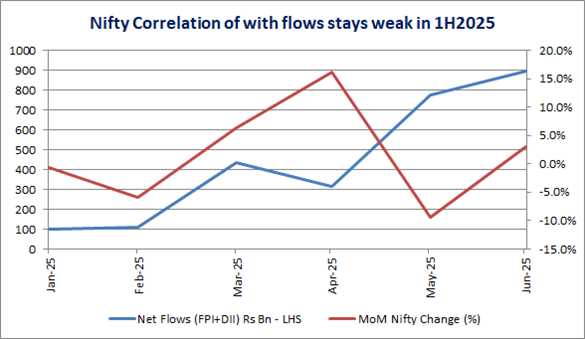India’s external debt hit US$736.3bn by March 2025, a 10% jump from last year, with a significant portion (over 41%) of the debt maturing soon. As the US threatens 500% tariffs on countries buying Russian oil, including India, investors need to evaluate: Can India afford a confrontation with the US, China and other major trade partners, and could it withstand a covert economic embargo? Here’s my take, may be naïve and ill informed, but nonetheless relevant.
India’s External Debt
According to the Reserve Bank of India (RBI) latest release, India’s external debt stood at US$736.3bn at the end of March 2025, with a debt-to-GDP ratio of 19.1%. Key highlights of the data are:
Long-Term Debt: US$601.9bn, up US$60.6bn from last year, with commercial borrowings and non-resident deposits driving growth. About 77% (US$568bn) of this debt is owed by non-government entities. The non-government debt is almost equally divided between financial institutions (US$271.3bn) and non-financial corporations (US$261.7bn).
Short-Term Debt: US$134.5bn, representing 18.3% of total debt and 20.1% of foreign exchange reserves.
Components: About one half of external liabilities (US$251bn) is loans and debt securities, 22% currency and deposits and 18% trade credit. The rest 10% includes IMF SDRs and intercompany lending by MNCs.
Maturity: 41.2% of the external debt (about US$305bn), is due to mature within the next 12 months.
Debt Sustainability: Foreign exchange reserves cover 92.8% of total debt, down from 97.4% a year ago, signaling a slight decline in buffer capacity.
Refinancing challenge
With over 40% of long-term debt maturing soon, India faces a refinancing challenge, particularly if global financial conditions tighten or trade disruptions escalate. India’s reliance on Russian oil, which accounts for 35-40% of its crude imports (2.08 million barrels per day in June 2025), has put it in the crosshairs of a proposed US Senate bill. The “Sanctioning Russia Act of 2025,” backed by Senator Lindsey Graham and reportedly supported by President Trump, proposes a 500% tariff on countries importing Russian energy to pressure Moscow over Ukraine. India, alongside China, buys 70% of Russia’s oil exports, making it a prime target.
Economic Impact: A 500% tariff on Indian exports to the US, India’s largest export market, could affect US$66bn (87% of India’s US exports), as per Citi Research estimates. This could disrupt key sectors like pharmaceuticals, IT, and textiles, potentially triggering inflation and job losses.
Oil Dependency: India imports 88% of its crude oil, with Russia offering competitive discounts. Switching to costlier suppliers like the US or Middle East could raise import costs significantly, straining India’s trade balance.
Can India Afford a Confrontation?
India’s economic fundamentals offer some resilience but also expose vulnerabilities.
Forex Reserves: At US$703bn (as of recent data), India’s reserves cover 92.8% of external debt, providing a cushion to manage maturing obligations. However, refinancing US$270.9bn in long-term debt within a year could pressure reserves, especially if US tariffs disrupt export revenues.
Trade Dynamics: The US accounts for a US$45.6bn trade deficit with India. A trade war could prompt reciprocal tariffs, but India’s 12% trade-weighted average tariff (vs. the US’s 2.2%) limits its leverage. Negotiations for a trade deal to cut tariffs on US$23bn of US imports are underway, signaling India’s preference for diplomacy over confrontation; notwithstanding some recent comments of senior ministers that suggest otherwise.
Oil Alternatives: India has diversified its oil imports, with the US supplying 6.3% (439,000 bpd in June 2025) and West Asia 35-40%. While switching from Russian oil is feasible, it would increase costs, potentially impacting fuel prices and inflation.
Can India Sustain Virtual Economic Sanctions?
Virtual economic sanctions, such as the proposed 500% tariffs, or Chinese embargo on export of critical components, chemicals, human resources etc., would act as a severe trade barrier.India’s ability to sustain them depends on several factors.
Energy Security: India’s strategic reserves (9-10 days of imports) and diversified suppliers (US, Nigeria, Middle East) provide short-term flexibility. However, replacing Russia’s 40% share at higher costs could strain refiners and consumers.
Economic Resilience: The RBI’s Financial Stability Report (July 2025) highlights strong banking sector metrics, with declining non-performing assets and robust capital buffers. This suggests India’s financial system could absorb some shocks, but prolonged trade disruptions could erode confidence.
Need for caution
India’s debt remains manageable for now, but over 41% debt maturity in 12 months calls for vigilance. Investors in Indian bonds or banking stocks should monitor refinancing risks.
A US tariff war could hit export-driven sectors like IT and pharmaceuticals hardest. India’s diplomatic efforts to secure a trade deal or tariff waiver will be critical. A successful negotiation could stabilize markets, while failure could spark volatility.
Conclusion
India’s US$736.3bn external debt and looming maturities pose challenges, but its reserves and diversified oil sources provide a buffer. A full-blown confrontation with the US seems unlikely, given India’s diplomatic push and economic stakes. However, sustaining virtual sanctions would strain India’s trade balance and energy costs, making de-escalation the smarter play.
The 41% of external debt (US$305bn) maturing within 12 months is significant, requiring substantial refinancing or reserve drawdowns. India’s US$703bn forex reserves provide coverage, but a US tariff war could reduce export revenues, complicating debt servicing.
Sustained 500% tariffs would disrupt exports, weaken the rupee, and increase debt servicing costs. The RBI’s strong banking sector provides some stability, but prolonged sanctions could erode investor confidence and slow growth.
India’s neutral geopolitical stance and trade deal negotiations (aiming to cut tariffs on US$23bn of US imports) indicate a strategy to avoid sanctions. A waiver or partial exemption is possible, given India’s strategic importance to the US.
Read with US$703bn may be just enough



















